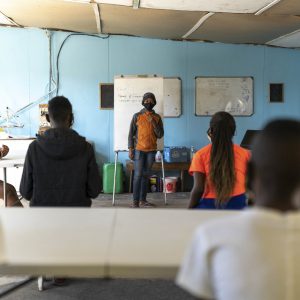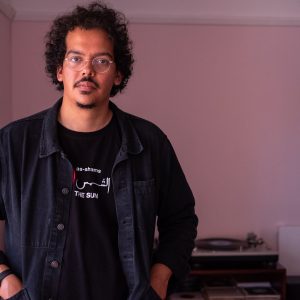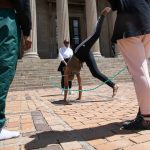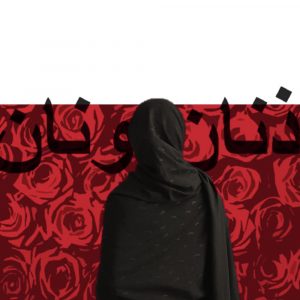New Books | Revolutionary Feminisms
Leanne Betasamosake Simpson – one of the many radical activists interviewed in this book – is a Nishnaabeg author who uses indigenous practices to respond to ongoing white violence.
Author:
11 November 2020

This is a lightly edited excerpt from Revolutionary Feminisms: Conversations on Collective Action and Radical Thought (Verso, 2020), edited by Brenna Bhandar and Rafeef Ziadah.
Leanne Betasamosake Simpson
An Indigenous (Michi Saagiig Nishnaabeg) artist, writer and scholar, Leanne Betasamosake Simpson has worked for over a decade as an independent scholar using Nishnaabeg intellectual practices. She has lectured and taught extensively at universities across Canada and has extensive experience with Indigenous land-based education. She holds a PhD from the University of Manitoba and teaches at the Dechinta Centre for Research and Learning in Denendeh.
Leanne is the author of five previous books, including This Accident of Being Lost, which won the MacEwan University Book of the Year; was a finalist for the Rogers Writers’ Trust Fiction Prize and the Trillium Book Award; was long listed for CBC Canada Reads; and was named a best book of the year by the Globe and Mail, the National Post, and Quill & Quire. Her latest book, As We Have Always Done: Indigenous Freedom Through Radical Resistance was published by the University of Minnesota Press in 2017, and was awarded Best Subsequent Book by the Native American and Indigenous Studies Association. Her new novel Noopiming: The Cure for White Ladies is forthcoming from House of Anansi Press in the autumn of 2020. As a musician, she also combines poetry, storytelling, songwriting and performance to create unique spoken songs and soundscapes.
BB/RZ: Can you tell us about your early political and intellectual formation? What were some of the major influences on your scholarly writing, your work as an educator and as a poet?
LBS: I often say that witnessing the so-called Oka Crisis during the summer of 1990 was my political education. The resistance at Kanehsatà:ke and Kahnawake, the leadership of Ellen Gabriel acting as spokesperson for the People of the Longhouse, the response from white Canada, and observing the beautiful, grounded solidarity of Indigenous nations across the country certainly set me on a trajectory and was most definitely my political awakening, as is true for many of my generation. Coming of age during the 1990s, I learned from the organising and mobilisation of the James Bay Cree over hydroelectric development, was involved with anti-racist organising on campus and was in proximity, at least geographically, to the organising of the Black community in Toronto. The 1990s, as Idil Abdillahi and Rinaldo Walcott write in their 2019 book Black Life: Post-BLM and the Struggle for Freedom, was the decade where 140 colonialism/capitalism/resistance Black cultural production in places like Toronto had fully emerged. Writers like Dionne Brand gave me language to name things I hadn’t been able to before.
It was during this time that I was first exposed to the writings of Indigenous peoples like Vine Deloria Jr, Patricia Monture-Angus and Lee Maracle. I first encountered the writings of bell hooks, Audre Lorde, Angela Y Davis, James Baldwin and Frantz Fanon. And, as I write about in As We Have Always Done, I also spent a lot of time on the land with Nishnaabeg elders, and this facilitated a very deep love and connection to land, story, language and Nishnaabeg life. That love is perhaps what has propelled my career for the past two decades.
BB/RZ: You have emphasised the importance of children in networks of learning and community building. You set out a powerful critique of the way the Canadian state has targeted Indigenous children (through the residential school system, for instance) as a core aspect of colonisation. Your work also very powerfully counters the way the care of children has become commoditised and sorely devalued in many (if not most) places. Can you tell us more about how you see the care of children as central to feminist, anticolonial, anticapitalist struggles?
LBS: This is a Nishnaabeg practice as I understand it; people of all ages were and are to be included and engaged in all aspects of life, and those engagements were and are predicated on consent, nonauthoritarianism, self-determination, noninterference, kindness, gentleness and a very deep form of caring. So, one would create and maintain an extended family life that embodies the sort of political and ethical life we want to create collectively. Our children were present during most of our economic, political, religious and daily activities, so they learned by doing, from observing and from being a part of things. Education took place on the land, and in the context of family and community. It was not institutionalised. While every person needed a foundation of life skills, young people were supported in finding and developing their gifts, their loves and their interests. This also meant that the way we did things accommodated the needs of children – for movement, joy, engagement and belonging. We can’t just bring children along to a boring three-day conference taking place inside a building and expect that this will bring out their best selves, nor can we expect all children to thrive in childcare settings at conferences where they are in an unfamiliar environment, with people they have never met. We certainly can bring children along to a three-day gathering taking place outside in the bush, with snowmobiles, food, fire, fishing, laughter and fun people to keep them entertained when the adults get into serious conversations.
Related article:
In my work at the Dechinta Centre for Research and Learning, we have identified the biggest barrier to postsecondary education for Indigenous women in the north as childcare, so we provide a land-based programme for kids to learn alongside their parents. This has been a very necessary and difficult part of this work, because the presence of children and their needs has a beautiful and significant impact on our programme. It simply doesn’t work to use a daycare sort of model, so rather, we view children as full participants and teachers and accept their influence as part of our learning. We recently hosted a solidarity gathering for BIPOC (Black, Indigenous and People of Colour) community organisers. Rather than hosting this in the city, we hosted it on an island in the lake, during the early part of spring. Participants brought their children. We snowmobiled out to the site, sat around a fire, set and fished nets together and shared food. The group of children had a blast, and although no one presented papers, we shared informally about our work and began to deepen our relationships to each other. Solidarity became very clear to each of us, as a responsibility. It sounds very simple, and in some ways it is. But this is a very old way of Indigenous organising, predicated on relationships and taking care. It is also a profoundly different way of interacting with people from other anticolonial movements.
BB/RZ: As a member of the Nishnaabeg First Nation, the concept of freedom that you have been developing and practicing is one rooted in Nishnaabeg intelligence, which incorporates emotional intelligence, land-based associative forms of knowledge (to draw on the words of Glen Coulthard), and is kinetic, that is, involves movement. It is a “whole body intelligence”, as you have written. Can you tell us more about your concept of freedom, particularly as it relates to feminist, anticolonial struggle?
LBS: It is a sort of relational or grounded freedom, meaning that it takes place in the context of a complex relationality with all of the other beings, communities and nations with whom we share time and space – one that is designed to propel life. It’s a freedom to individually and collectively determine the world in which we live. I’ve learned about this sort of freedom on the land and by practicing it. Think back to the solidarity gathering I described earlier. The children were running around playing, laughing, interacting with each other and the rest of the group in the context of sharing, kindness, gentleness and care. Procedurally, the group was making decisions using consensus and care, fully aware that not everyone feels comfortable on the land and outside of their home environments. To me, this is a glimpse of grounded freedom – a sort of freedom that Indigenous peoples under occupation have almost no experience of feeling and being immersed in. A sort of freedom that is an individual and collective practice, designed to promote the wellbeing and self-determination of both the individual and the communal as interlocking projects. It does not therefore mean one can do whatever they want without hindrance, because causing harm to oneself or to other living beings is not ethically acceptable. But it does mean that one can be self-determining in the context of shared values and practices. In this context, colonial impositions like heteropatriarchy and anti-Blackness, and the internal replication of these systems of harm, are an attack on grounded freedom.
BB/RZ: In the context of writing about the Radical Resurgence Project, you develop the idea of “generative refusal”. What is “generative refusal” and why is it important to anticolonial and anticapitalist struggles?
LBS: In its simplest form, for Indigenous peoples it means not just rejecting, critiquing and dismantling colonialism and its adjacent projects (although this is crucial), but generating, building, making, organising and struggling to create and actualise alternatives, even if those iterations are failures. It means continually engaging in the process of making something better, because every time we do that, we unlock theory and knowledge about how to do that. This doesn’t mean organising in a haphazard fashion; to me, it means being fully aware and articulate about how those who have gone before us have organised and struggled, how other anticolonial movements adjacent to us are organising and struggling.
There are and have been many, many sites of generative refusals over the past four centuries of colonialism, and really, it is the generative refusal of my ancestors that ensured that I exist and can function as Nishnaabeg. Each generation inherits this struggle and a particularly temporal iteration of this struggle, and it is our collective responsibility to contribute to the making of Indigenous life, in spite of whatever eliminatory forces are working against us. Generative refusal, then, is a presencing – it is concerned with using all of the individual and collective tools available to us to make a different present, which inevitably gives birth to the future. There are so many sites of this in our communities, whether it is families passing along language, songs and stories; moments of urban organising that create (often temporary) spaces of decolonial potential where we live out our theories and ethics; spaces of Indigenous resistance and life created by blockades, and the networks of care that we build to support those actions; collectives of artists intervening with visions of possibility; and solidarities with anticolonial movements generating affirmation, shared experience and respect for differences.
Related article:
BB/RZ: First Nations have long been “internationalist” in outlook. This has two very different meanings. On the one hand, as you set out in your work, there are the complex relationships of diplomacy between First Nations, and then also, with plant worlds, animal worlds and nonhuman life forms. On the other hand, there is the history of First Nations political activism in broader, internationalist anticolonial coalitions. Can you tell us about the significance of these different aspects of First Nations’ internationalism?
LBS: There is a tendency to view Indigenous peoples and Indigenous knowledge as only locally generated and oriented systems that come from an intimate, land-based existence – which is, of course, true, but it demonstrates a limited understanding of Indigenous thought. Indigenous politics and ethics frame this differently. We are peoples with reciprocal relationships of life, through which we have always ethically shared land, time and space with plants, animals and other humans, stretching back to the past and reaching forward to coming generations. Our peoples have always been philosophically and materially interested in the nations of life that make up our universe, our universe as a life-generating system, both inside our spheres of influence and outside those circles. Our deep relationality exists in both intra- and interdependent ways across scales, and so these different aspects of internationalism are intrinsically associated; one gives birth to another. For instance, I believe Nishnaabeg ethics requires me to act and live in solidarity with movements for Black life in Toronto, the Zapatistas in Chiapas and Palestinian struggles for freedom in Palestine. Many Indigenous nations have long histories of connecting to, sharing with and learning from and standing beside these movements as co-resistors. Indigenous societies were never insular – we have always practiced complex diplomatic relations with other forms of life.
BB/RZ: Relatedly, can you tell us about how you see the concept of the nation, and how it differs from the Westphalian nation-state system and its nationalisms that are rooted in imperialism, racism and exclusion?
LBS: Indigenous nationhoods are not built upon enclosure, borders, authoritarian power, violence or even exclusive use. Indigenous nationhoods are not a replication of the nation-state and the violence required to maintain statehood; in the context of colonialism, they are a generative refusal of the Westphalian nation-state system. Indigenous nationhoods are a different way of organising life, structuring the ways we live and relate to the worlds around us, and this should be done in a manner that not only refuses and dismantles anti-Blackness, white supremacy, capitalism and heteropatriarchy, but generates alternatives based on deep relationality, grounded solidarities, the self-determination and freedom of our co-resistors and, of course, a bringing forth of more life. Thought of in this way, Indigenous nationhood cannot fully exist alongside capitalism. It can most certainly share land and space with those communities and nations interested in living with the sanctity of the land, and with a plurality of other nations and collectives already doing so.
Related article:
BB/RZ: Indigenous feminisms in Canada (and the Americas more broadly) are distinctive from other radical feminist traditions such as Black feminism and Third World feminisms, but also grapple with the effects of colonialism on racialised women and sexual minorities. Could you tell us about some of the differences and contact points between Indigenous feminisms and other feminist traditions that you have found exhilarating, or challenging, or both?
LBS: For me, I understand heteropatriarchy as something that was injected into my nation and our people by the colonisers as a mechanism to control, manipulate and eliminate our bodies, minds and spirits, our solidarities and our connection to our lands. This was done strategically, because heteropatriarchy in its most violent forms removes people from the land very quickly and efficiently. It destroys the intimacy that connects people to each other, and it attacks our ability to effectively organise against it. Although certain target segments of society – Two Spirit and queer people, women and children – experience the violence in an asymmetrical fashion, it impacts all families and all genders and the entire nation. Engaging in the replication of heteropatriarchy, to me, is a betrayal of our most cherished values and ethics.
As I write in As We Have Always Done, Nishnaabeg society has a plurality of genders and sexual orientations that wasn’t exceptional, because it was normal to respect diversity and live in a manner that supported individuals, both in being self-sufficient and in being self-actualising, becoming their best selves. This was visible to the colonisers and read as both a threat and a barrier to the exploitation of land and natural resources; and so, it was queer Indigenous peoples that were first violently targeted for elimination. The state, working in cohort with the church, infused our communities with a heteropatriarchy designed to replicate Victorian gender roles reinforced by both intimate and structural violence. Generations of Indigenous children were indoctrinated into this heteropatriarchy at residential schools, at the same time that our communities were faced with forced relocation, waves of epidemics, dispossession of land and economic means, and Christianisation, while the 1876 Indian Act rendered our political systems inert and encoded homophobia, transphobia and sexism into daily life. Physical, sexual and emotional violence was inflicted on all genders as part of the colonial project by the state, until they had created a system where we simply replicated the trauma, violence and harm in our own communities. White women were often accomplices and working in cohort with the state to advance this harm, and white mainstream feminism and second-wave feminism haven’t been particularly useful tools in addressing these issues in our communities. Issues of gender in Indigenous communities, therefore, are complex, and many kinds of feminism, particularly white mainstream feminist analyses, are too simplistic and racist to be of use in our world-building projects. We can only start where our communities and where our peoples are, and with their immediate needs. Our ethics demand that we do this with care.
I am exceedingly grateful to Black feminists – radical, world-building Black people who are providing incisive analysis on white supremacy, capitalism and heteropatriarchy, while also responding to the needs of the Black community – for their writing and example in navigating similar, but not identical, issues in their own projects for Black life and Black freedom. For decades now, they have challenged me to think, rethink, think otherwise, to ask questions of myself and my people, to refuse whiteness. To organise, continuously, tirelessly, from a place of strength, against the eliminatory practices of the state, and to do this with a profound love for community.
Related article:
BB/RZ: You write that Nishnaabeg ethical practices require you to “engage not just with their theories but with the people and peoples that embody and enact these theories”. Solidarity, in other words, requires you to develop “relationships of reciprocity and co-resistance” with revolutionary movements emanating from the Global South, with radical Black thinkers and activists, abolitionists and so on. Can you tell us more about what this looks like? Are there any examples you can draw on to tell us about the meaning of relationships of reciprocity?
LBS: Indigenous peoples have a long history of this, although this history doesn’t appear in the literature very often, as of yet. My colleague Glen Coulthard is doing a lot of this work in his own nation, the Dene. In his book Red Skin, White Masks (2014), he demonstrates how Dene thought intervenes theoretically in Marxism, and his more recent work concerns the Dene’s engagement with anticolonial thought in the 1960s and 1970s, and their connections to places like Tanzania. He is also documenting some of the Native organising at this time on the west coast of Canada and its connection to the Black Panthers and Maoism. This work has translated into relationship building at the Dechinta Centre for Research and Learning, where we both work, with organisers from the Black Lives Matter Freedom School in Toronto, and interlocutors from various movements in Canada and the United States. In my own territory, Black activists in Toronto stood in solidarity with us during Idle No More. We have more work to do in terms of coming to terms with anti-Blackness, but I am encouraged by folks in both movements supporting each other materially, and beginning to build relationships. Black Lives Matter, in its various forms and manifestations, provided me personally with an incredibly well-organised, well-executed response to white violence.




